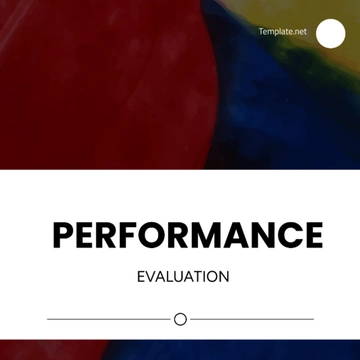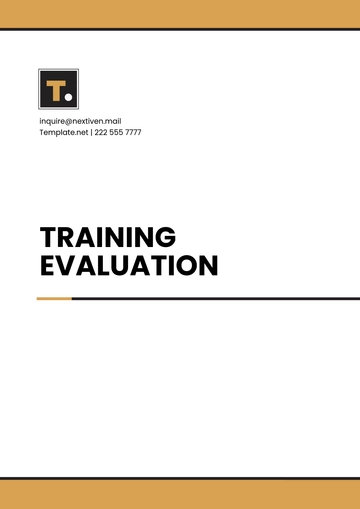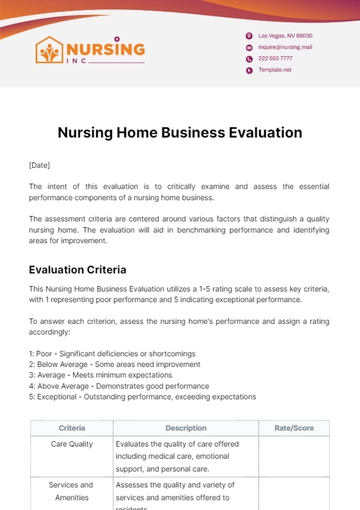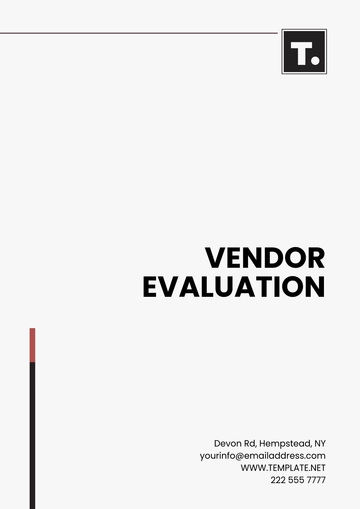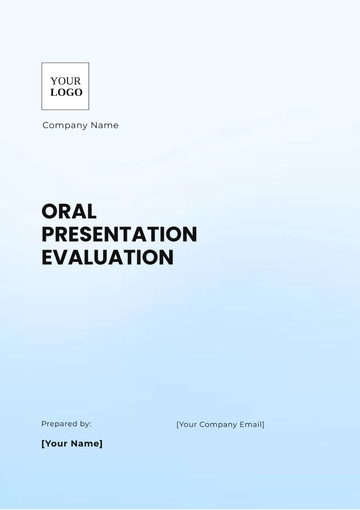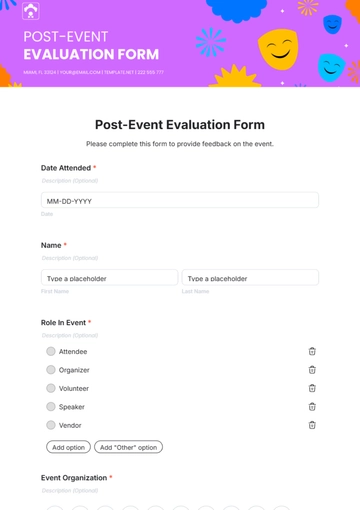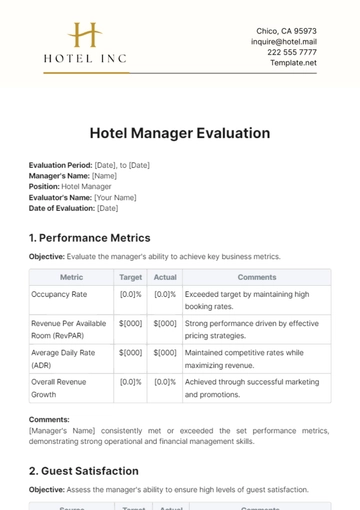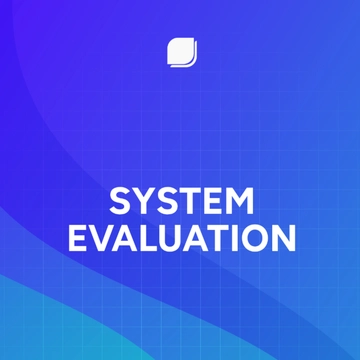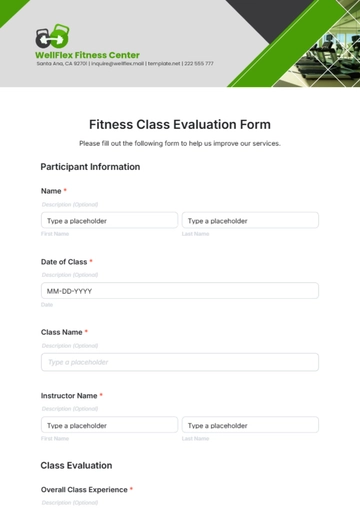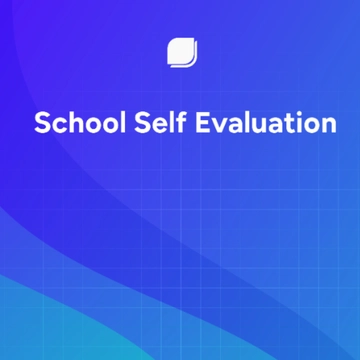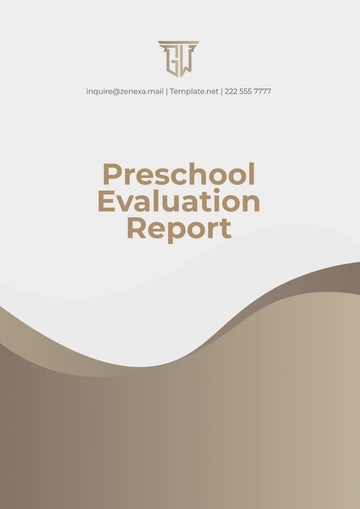Free Marketing Evaluation and Feedback System for Expenditure

1. Executive Summary
In the ever-evolving landscape of marketing, the ability to assess the effectiveness of expenditure and gather actionable feedback is paramount for [Your Company Name]'s sustained growth and success. The Marketing Evaluation and Feedback System for Expenditure, meticulously crafted for the year [Year], emerges as a strategic compass to navigate this complex terrain.
A. Purpose and Significance:
The primary purpose of this system is to establish a structured framework for comprehensively evaluating our marketing expenditure while concurrently harvesting feedback from diverse stakeholders. It bridges the gap between investment and results, ensuring that every marketing dollar is judiciously spent and that our strategies are agile and responsive.
At the heart of this system lies a commitment to data-driven decision-making. It enables us to decipher the true impact of our marketing investments, quantifying not just costs but also returns. By tracking key performance metrics such as Return on Investment (ROI), Customer Acquisition, Conversion Rates, and Customer Lifetime Value (CLV), we gain an unobstructed view of how our marketing expenditure aligns with our overarching business goals.
Equally pivotal is the collection of feedback from various sources, including customers, employees, and partners. Their insights and perspectives are invaluable in refining our marketing strategies, enhancing customer experiences, and nurturing employee engagement. This feedback loop is not merely an afterthought but an integral component of our continuous improvement efforts.
B. A Holistic Approach:
The Marketing Evaluation and Feedback System for Expenditure is not confined to numerical data alone. It delves deep into qualitative insights, seeking to understand the intricacies of customer preferences, market dynamics, and employee sentiments. It empowers us to answer critical questions:
What marketing initiatives drive the most substantial returns, and how can we replicate their success?
What pain points do our customers encounter, and how can we alleviate them to foster loyalty?
How do our employees perceive our marketing strategies, and how can we enhance their alignment with our goals?
C. Actionable Insights:
One of the key strengths of this system lies in its capacity to translate data and feedback into actionable insights. Through categorization, prioritization, and thorough analysis, it identifies areas where adjustments are warranted. The resulting action plans, whether they involve product enhancements, employee training, or reallocation of budget resources, are grounded in empirical evidence and geared towards achieving tangible outcomes.
In a marketing landscape characterized by fluidity and complexity, the Marketing Evaluation and Feedback System for Expenditure is our compass, guiding us towards informed decisions, optimal resource utilization, and a relentless pursuit of excellence. As we embrace the challenges and opportunities of [Year], this system stands as a testament to our commitment to transparency, efficiency, and a customer-centric approach. With it, we are poised to navigate the future with confidence, agility, and an unwavering focus on achieving our marketing goals.
2. Objectives
The objectives of the Marketing Evaluation and Feedback System for Expenditure are multifaceted, designed to facilitate a comprehensive and data-driven approach to assessing marketing expenditures while concurrently gathering valuable feedback. These objectives serve as the guiding principles that underpin the system's implementation in the year [Year]:
A. Evaluate Expenditure Effectiveness:
To assess the impact and effectiveness of our marketing expenditures in achieving predefined business objectives.
To determine the Return on Investment (ROI) for each marketing initiative, ensuring that resources are allocated judiciously and yielding measurable returns.
B. Enhance Customer Experiences:
To gather customer feedback that reveals pain points, preferences, and suggestions for improvement.
To use customer insights to refine marketing strategies, ultimately enhancing customer experiences and fostering loyalty.
C. Improve Employee Engagement:
To solicit feedback from employees involved in marketing activities, understanding their perspectives on strategies, challenges, and opportunities.
To use employee feedback to align marketing efforts with organizational goals and improve engagement and collaboration among teams.
D. Foster Continuous Improvement:
To create a feedback loop that enables a continuous improvement cycle for marketing strategies and campaigns.
To ensure that marketing activities are agile and responsive, adapting to changing market dynamics and stakeholder expectations.
E. Optimize Budget Allocation:
To identify areas of over expenditure or underutilization within the marketing budget.
To enable data-driven budget adjustments, ensuring that resources are allocated to initiatives with the greatest potential for impact.
F. Strengthen Stakeholder Relations:
To demonstrate a commitment to listening to and acting upon feedback from customers, employees, and partners.
To nurture strong relationships with stakeholders by valuing their insights and contributions to our marketing efforts.
G. Drive Data-Driven Decisions:
To cultivate a culture of data-driven decision-making within the marketing department and across the organization.
To empower teams with the information needed to make informed choices that lead to optimal marketing outcomes.
H. Enhance Competitive Edge:
To gain a competitive edge by leveraging insights and feedback to refine marketing strategies and stay ahead in a rapidly changing market.
To identify and capitalize on emerging trends and opportunities that can propel [Your Company Name] ahead of competitors.
These objectives collectively form the framework of our Marketing Evaluation and Feedback System for Expenditure, serving as the foundation upon which we build a robust and adaptive approach to marketing assessment and improvement in the dynamic landscape of [Year].
3. Data Collection
In the dynamic landscape of marketing in [Year], data collection stands as the foundational cornerstone of our Marketing Evaluation and Feedback System for Expenditure. It is through this meticulous process that we gain access to the insights and information necessary to steer our marketing strategies with precision and agility.
Sources: Our data collection encompasses a spectrum of sources, ranging from digital analytics platforms and customer surveys to employee feedback channels and market research. This diverse array of sources ensures that we cast a wide net, capturing data from customers, employees, partners, and the market at large. By weaving together these various data threads, we create a holistic tapestry that paints a vivid picture of our marketing landscape.
Frequency: The frequency of data collection is a critical aspect of our approach. We understand that the marketing landscape is not static but rather a dynamic ecosystem that evolves rapidly. As such, we adopt a rhythm of regular data collection, ensuring that we have access to up-to-date insights. The frequency varies depending on the source and the nature of the data, with some sources providing real-time data while others are assessed on a quarterly or annual basis.
Responsible Parties: Our approach to data collection is collaborative, involving various responsible parties within the organization. These parties, including the marketing team, sales team, HR, and finance teams, each play a crucial role in sourcing and managing relevant data. By distributing these responsibilities, we create a sense of ownership and accountability, ensuring that the data collected is accurate, relevant, and actionable.
In summary, data collection is the heartbeat of our Marketing Evaluation and Feedback System for Expenditure. It empowers us with the insights needed to make informed decisions, adapt to changing market conditions, and steer our marketing strategies toward success in the ever-evolving landscape of [Year].
4. Performance Metrics
In the realm of marketing, understanding the impact of our efforts is paramount. The Performance Metrics section of our Marketing Evaluation and Feedback System for Expenditure is dedicated to the quantifiable measures that illuminate the effectiveness of our marketing expenditures. By tracking and analyzing these key performance metrics, we not only gauge our success but also uncover areas for improvement and optimization.
Performance Metrics Table:
Metric | Measurement Method | Frequency | Responsible Party |
ROI | Revenue / Cost | Monthly | Marketing Team |
Customer Acquisition | New customers | Quarterly | Sales Team |
Conversion Rate | Conversions / Visits | Monthly | Web Analytics |
Customer Lifetime Value (CLV) | CLV | Annually | Finance Team |
A. ROI (Return on Investment):
Measurement Method: Calculated as Revenue divided by Cost.
Frequency: Assessed on a monthly basis.
Responsible Party: The Marketing Team is tasked with monitoring and evaluating ROI. This metric provides a clear picture of the financial returns generated by our marketing efforts compared to the costs incurred.
B. Customer Acquisition:
Measurement Method: Tracking the number of new customers acquired.
Frequency: Evaluated on a quarterly basis.
Responsible Party: The Sales Team is responsible for tracking and reporting customer acquisition. This metric allows us to measure the effectiveness of our marketing in expanding our customer base.
C. Conversion Rate:
Measurement Method: Calculated as Conversions (desired actions) divided by Visits.
Frequency: Assessed on a monthly basis.
Responsible Party: Web Analytics teams are tasked with monitoring and analyzing conversion rates. This metric reflects the efficiency of our marketing in turning website visitors into engaged customers.
D. Customer Lifetime Value (CLV):
Measurement Method: Calculated as CLV.
Frequency: Evaluated on an annual basis.
Responsible Party: The Finance Team is responsible for calculating and assessing CLV. This metric helps us understand the long-term value of our customers and informs budget allocation decisions.
These performance metrics serve as our compass, guiding us through the intricate terrain of marketing expenditures. By meticulously tracking and analyzing these key indicators, we ensure that our resources are allocated judiciously and that our strategies remain finely tuned to achieve success in the dynamic landscape of [Year].
5. Feedback Collection
In our quest for comprehensive evaluation and continual improvement, the collection of feedback is an invaluable component of our Marketing Evaluation and Feedback System for Expenditure. We understand that insights from diverse stakeholders, including customers, employees, and partners, are instrumental in shaping our marketing strategies and ensuring their relevance and effectiveness in the ever-evolving landscape of [Year].
From Customers: We actively solicit feedback from our customers through various channels, including surveys, feedback forms on our digital platforms, and direct communication. Customer feedback provides us with valuable insights into their preferences, pain points, and expectations. It helps us tailor our marketing efforts to meet their needs, improve their experiences, and build enduring relationships.
From Employees: Our employees, who are integral to the execution of our marketing strategies, play a crucial role in this feedback loop. We encourage open and candid discussions, welcoming their suggestions and observations. Employee feedback provides a unique perspective on the challenges and opportunities within our marketing initiatives, fostering a sense of ownership and collaboration.
From Partners: We value the perspectives of our partners, who often have a nuanced understanding of market dynamics and trends. Through ongoing dialogue and collaboration, we gather insights and feedback that help us align our marketing strategies with the broader industry landscape. This collaborative approach enhances the effectiveness of our marketing efforts.
The process of feedback collection is not static; it is dynamic and responsive, designed to adapt to changing market conditions and stakeholder expectations. Through this multi-faceted approach to feedback collection, we ensure that our Marketing Evaluation and Feedback System for Expenditure remains agile and informed, guiding us towards optimal marketing outcomes in [Year] and beyond.
6. Feedback Analysis
Collecting feedback is just the first step in our journey toward refining and optimizing our marketing strategies in [Year]. Equally critical is the systematic analysis of the feedback we gather. This section is dedicated to outlining our meticulous process of feedback analysis, which encompasses categorization, prioritization, and actionability.
Categorization: The initial phase of feedback analysis involves categorizing the feedback into distinct segments. We categorize feedback based on its source, nature, and relevance to specific marketing initiatives. This categorization allows us to identify trends and recurring themes, pinpointing areas that require attention. Whether it's customer feedback on product experiences, employee suggestions regarding marketing campaigns, or partner insights on industry trends, we ensure that every piece of feedback finds its rightful place within our analysis framework.
Prioritization: Not all feedback carries the same weight in terms of its potential impact on our marketing strategies. Prioritization is a critical step in our analysis process. We assess feedback based on its significance, feasibility of implementation, and alignment with our overarching objectives. High-priority feedback is identified and earmarked for immediate attention and action. This ensures that we focus our resources and efforts on addressing issues and opportunities that can make a substantial difference in our marketing effectiveness.
Actionability: Feedback analysis is not a passive endeavor. It's the catalyst for action. We recognize that the true value of feedback lies in our ability to translate it into actionable insights. For every category of feedback, we develop clear action plans that outline the steps required for improvement or optimization. These action plans are assigned to responsible parties and accompanied by timelines to ensure accountability and progress tracking.
Our approach to feedback analysis is dynamic, agile, and deeply rooted in our commitment to continuous improvement. By categorizing, prioritizing, and acting upon feedback from customers, employees, and partners, we reinforce our dedication to staying responsive and relevant in the swiftly evolving marketing landscape of [Year]. This process is our bridge from insights to action, enabling us to refine our strategies, enhance customer experiences, and drive our marketing initiatives toward excellence.
7. Action Plans
In the pursuit of excellence, feedback and data are not mere observations but catalysts for action. The Action Plans section is where the insights gained from feedback and performance metrics are transformed into concrete strategies. In the dynamic landscape of marketing in [Year], these action plans ensure that we remain agile and responsive, continuously optimizing our marketing efforts.
Action Plans Table:
Feedback Category | Proposed Actions | Responsible Party |
Customer Feedback | Enhance product features based on customer suggestions | Product Team |
Employee Suggestions | Implement training programs to improve marketing skills | HR and Marketing |
These action plans represent the bridge between insights and impact, guiding us toward meaningful improvements in our marketing strategies and outcomes. They embody our dedication to responsiveness, adaptability, and a relentless pursuit of excellence in [Year] and beyond.
8. Budget Adjustments
In the fluid landscape of marketing in [Year], budget adjustments are not a mere contingency plan but an integral part of our proactive approach to optimizing marketing expenditure. This section outlines our systematic methodology for making budget adjustments, a process informed by a delicate balance between performance metrics and valuable feedback.
Performance Metrics-Informed Adjustments: Our budget adjustments begin with a thorough analysis of performance metrics. By closely monitoring metrics such as ROI, Customer Acquisition, Conversion Rates, and Customer Lifetime Value, we gain valuable insights into the effectiveness of our marketing expenditures. When performance metrics indicate that certain initiatives are exceeding expectations and delivering outstanding returns, we are poised to allocate additional resources to maximize their impact. Conversely, if certain areas are underperforming or failing to meet predefined targets, we have the flexibility to reallocate resources or adjust budgets accordingly to address these shortcomings.
Feedback-Driven Adaptations: Feedback, sourced from customers, employees, and partners, is another crucial driver of budget adjustments. Valuable insights gleaned from these stakeholders may reveal opportunities for fine-tuning our marketing strategies or optimizing our expenditure. For instance, if customer feedback highlights a particular marketing channel or campaign that resonates exceptionally well, we are prepared to channel additional resources into that area to capitalize on its success. Similarly, employee suggestions may lead to modifications in our marketing tactics that can be implemented within existing budget parameters.
The synergy between performance metrics and feedback in our budget adjustment process ensures that our marketing expenditures remain dynamic, agile, and finely tuned to achieve optimal outcomes in the rapidly evolving marketing landscape of [Year]. It is not merely a reactionary measure but a strategic approach to resource allocation that propels us toward marketing excellence.
9. Reporting
Transparency and accountability are the cornerstones of our marketing endeavors in [Year]. The reporting process is where we translate data, feedback, and action plans into comprehensive insights that guide our decisions and demonstrate our commitment to excellence. This section elucidates our reporting process, encompassing report format, frequency, and distribution.
Report Format: Our reports are designed to be clear, concise, and actionable. They are structured to provide a holistic view of our marketing performance, highlighting key performance metrics, feedback insights, and the status of action plans. Visual aids, such as charts and graphs, are employed to make data interpretation seamless. The report format allows stakeholders to grasp the state of our marketing efforts at a glance, facilitating informed decision-making.
Frequency: Reporting is an ongoing process, reflecting the dynamic nature of marketing. We provide regular updates, typically on a monthly basis, to ensure that stakeholders have access to the latest data and insights. However, certain reports, such as annual budget assessments or deep-dive performance reviews, may be delivered on a less frequent but more comprehensive schedule.
Distribution: Reports are distributed to a wide spectrum of stakeholders, including executive leadership, department heads, marketing teams, and relevant partners. By ensuring broad distribution, we foster transparency and inclusivity, empowering all stakeholders with the information needed to align their efforts with our marketing goals.
In essence, reporting is not just a formality; it's the culmination of our commitment to data-driven decision-making and continuous improvement. It's the medium through which we convey our progress, challenges, and opportunities, enabling all stakeholders to work in concert toward marketing excellence in [Year] and beyond.
10. Conclusion
In the dynamic and ever-evolving landscape of marketing in [Year], an effective Marketing Evaluation and Feedback System for Expenditure stands as the linchpin of our success. It empowers us with insights, fosters responsiveness, and fuels continuous improvement. By harnessing the power of data, feedback, and action, we are poised to achieve our marketing goals and navigate the challenges of the future with precision and excellence.
11. Appendices
Additional resources related to marketing expenditure evaluation and feedback are attached.
This template serves as a comprehensive guide for [Your Company Name] to systematically evaluate marketing expenditures, collect valuable feedback, and make informed decisions to enhance marketing effectiveness in the dynamic landscape of [Year].
- 100% Customizable, free editor
- Access 1 Million+ Templates, photo’s & graphics
- Download or share as a template
- Click and replace photos, graphics, text, backgrounds
- Resize, crop, AI write & more
- Access advanced editor
Enhance expenditure evaluation with the Marketing Evaluation and Feedback System for Expenditure Template, exclusively on Template.net. This editable and customizable system streamlines feedback collection. Tailor criteria effortlessly with our Ai Editor Tool, ensuring precise analysis. Elevate your financial strategies with flexibility and clarity, optimizing expenditure for efficient resource allocation.

